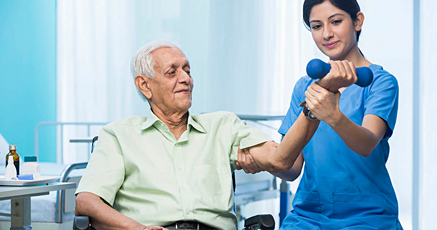Your Cart is Empty
July 06, 2021 3 min read
In this article we direct 4 questions to the team at K.H Poon Physiotherapy to better understand how physiotherapy can help older adults.
1. Could you give a short introduction about yourself and your role as a physiotherapist?
I am working as an allied health professional (AHP) - a full-time physiotherapist at K.H. Poon Physiotherapy, a private healthcare service provider offering physiotherapy for people with musculoskeletal and neurological disabilities.
My role as a physiotherapist involves improving the health and quality of life of the clients under my care. This is achieved through assessing and identifying my clients’ presenting complaints and using clinical reasoning and knowledge of health-improving solutions to address and remedy their physical disabilities. I also co-manage patients under the care of general practitioners and surgeons, as well as other physiotherapist colleagues.
2. Do you receive many elderly clients? What are the common problems that seniors face?
Our clinic sees a significant number of older patients who are above the ages of 60-70.
The most common issue that elderly people face is weakness; overall loss of strength in body, arms and legs. Weakness can come as a result of age-related changes, malnutrition, loss of mobility, and even social isolation. Weakness can contribute to many other secondary problems, such as an increased risk of falls, further loss of mobility due to increased effort needed to perform tasks, dependency, vulnerability, and low self-esteem.
3. How does physiotherapy help the elderly?

Various physiotherapeutic approaches can be employed to help the elderly. For those who recovering from injuries or surgery, physiotherapy can provide elderly with strategies and exercises focused on guided return to activity and exposure to gradually increasing levels of mobility in a safe manner.
Pre-emptively, a progressive tailored exercise that addresses the problem of weakness in an elderly person can improve strength and overall tolerance to activity. Physical activity and resistance training is a crucial way to maintain and improve physical strength by addressing muscle and mobility loss, thereby improving independence and self-reliance. Resistance training shows benefits such as increased muscle strength and power, reduced disability and fatigue, and a decreased likelihood of admission into a hospital or nursing home. Improved strength can also decrease fall risk, an issue faced by elderly everywhere. Teaching fall recovery can also provide elderly with strategies on how to safely recover from a fall.
4. What are some common causes for loss of mobility among seniors?


However, there are certain environmental or lifestyle situations where an elderly person may find themselves in a position of losing mobility. For instance, living a sedentary lifestyle or being dependent on others for help, or being socially isolated can reduce motivation to remain active and independent, or wholly deprive an older person of reasons to do so.
On the other hand, having an outlook of enjoying family time, travelling, or engaging in activities with groups of friends can promote mobility and a social life. An individual's attitude or mindset of approaching one's golden years is extremely significant, and can affect all the above factors. The choice to do nothing is a decision that can have a bigger impact than most people realise.
Read Part 2 of our interview with K.H Poon Physiotherapy where we cover managing mobility in seniors with exercises!
Comments will be approved before showing up.

March 11, 2025 2 min read
Sudden cardiac arrest (SCA) is a leading cause of death worldwide, often striking without warning. While waiting for emergency responders, every second counts, and having an Automated External Defibrillator (AED) at home could mean the difference between life and death.
Sign up to stay updated on our latest events, products and promotions.